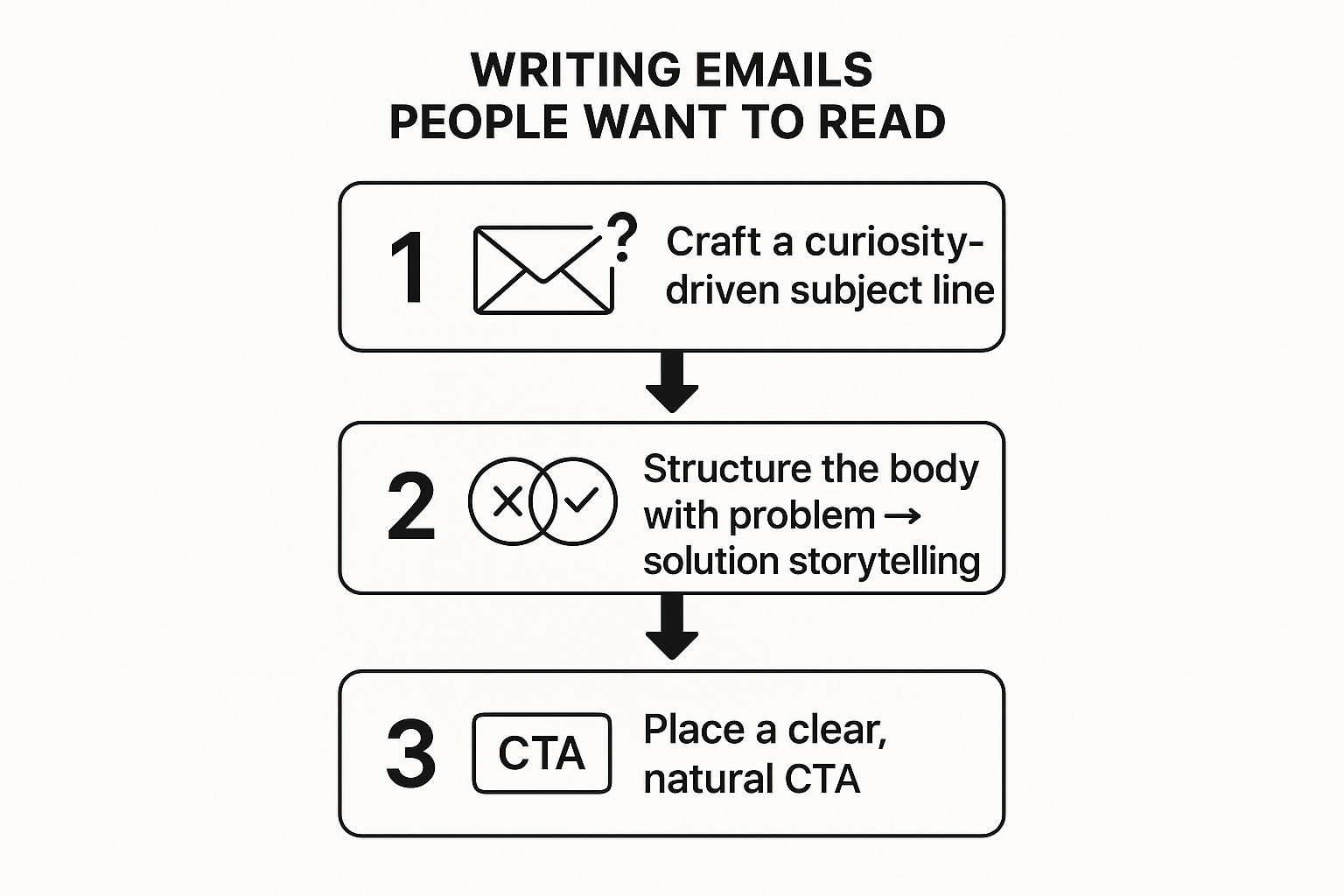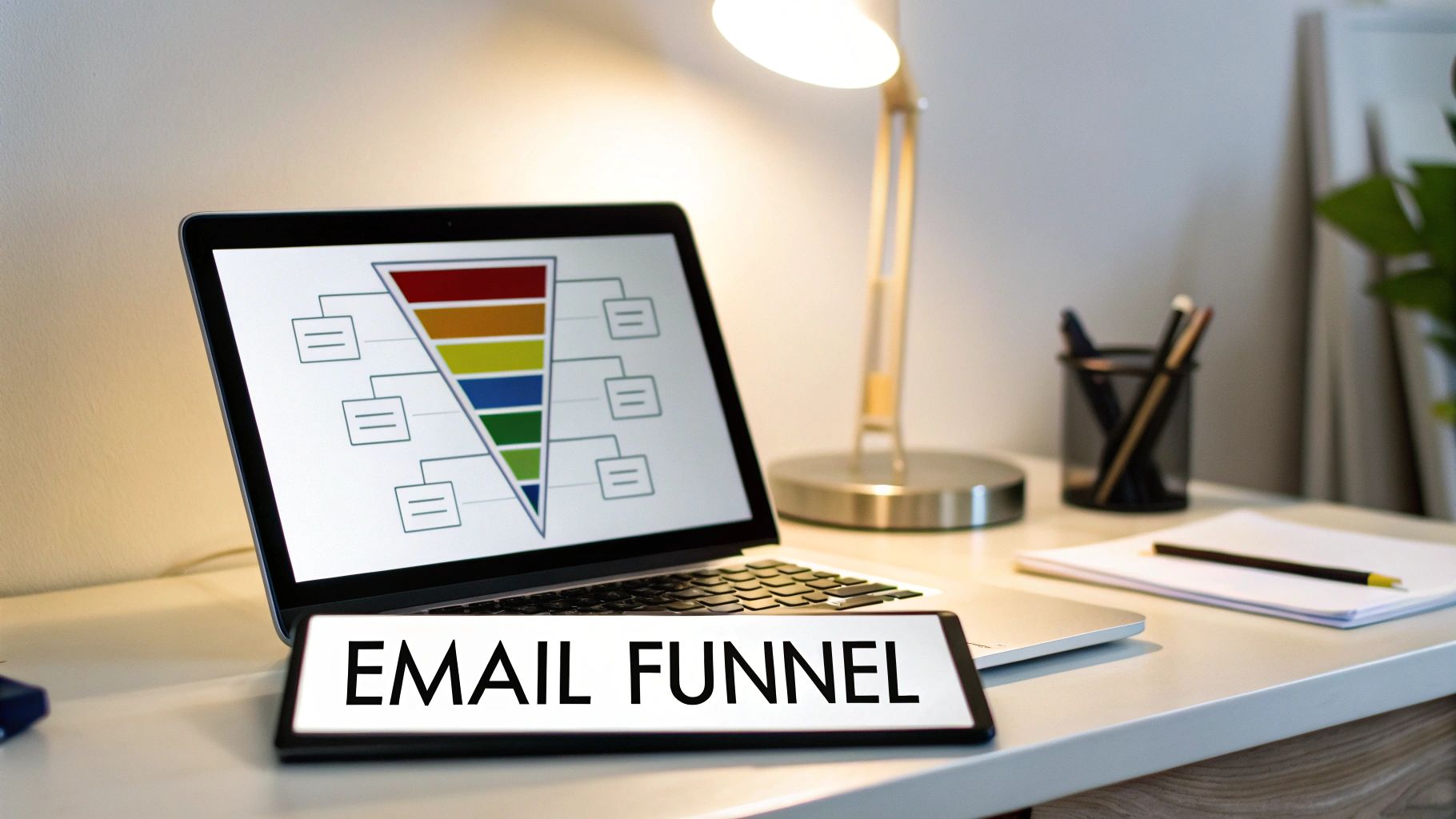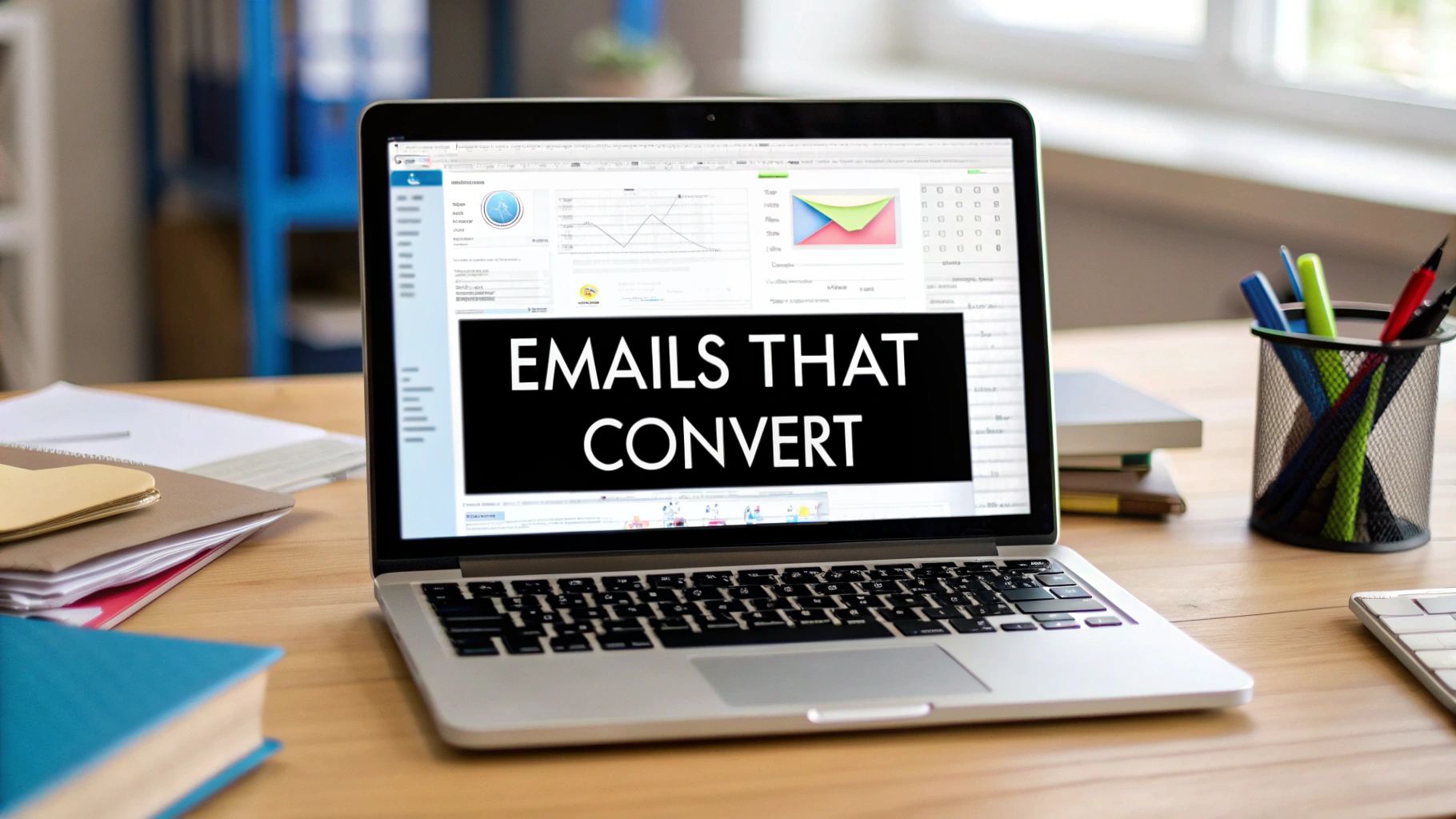So, what exactly are affiliate marketing emails? In a nutshell, they’re messages you send to your email list to recommend another company's products. For every sale you drive, you get a commission. But here's the key difference from a standard sales email: it's all built on trust. The best affiliate emails don't feel like an ad at all. They feel like a genuinely helpful tip from someone your subscribers know and respect.
Why Most Affiliate Marketing Emails Fail

Before we dive into writing, let’s talk about why so many of these emails end up in the trash. It almost always comes down to one thing: a lack of trust. When your audience doesn’t trust your recommendation, your email is just another piece of junk clogging up their inbox.
The biggest trust-killer? Promoting a product that makes zero sense for your audience. If you're sending a pitch for a high-tech drone to your list of home gardeners, you’ve got a serious disconnect. That kind of mismatch screams one of two things: you either have no clue who your audience is, or you'll promote anything for a quick buck. Both are fatal to the relationship you've built.
Choosing Products That Actually Help
Your journey to a successful affiliate email campaign doesn't start with a catchy subject line. It starts with a smart, deliberate product choice. Your promotions need to feel like authentic recommendations, not just another sales pitch.
Before you even think about partnering with a brand, run through this checklist:
- Does this actually solve a problem for my audience? If your subscribers are struggling with meal prep, a subscription box for healthy ingredients is a perfect fit. A random clothing brand? Not so much.
- Have I used it myself? Your personal experience is your most powerful selling tool. When you can share your own results, stories, or even minor critiques, it proves your recommendation is genuine. A generic product description copied from their website is a massive red flag for any sharp subscriber.
- Is the company reputable? Partnering with a brand known for terrible customer service can tarnish your own credibility just by association. Do your homework.
So many affiliate emails tank because they're full of common email marketing mistakes. A thoughtful approach to product selection helps you sidestep most of those issues right from the get-go.
The secret to great affiliate marketing isn’t selling; it's serving. When you genuinely believe a product will solve a real pain point for your audience, the email practically writes itself. That conviction is more persuasive than any sales copy you could ever write.
The Non-Negotiable Rules of the Game
Beyond picking the right product, there’s the unglamorous but essential work of compliance and disclosure. If you want to build a sustainable, trustworthy business, you have to play by the rules. This part isn’t optional.
For instance, the Federal Trade Commission (FTC) in the U.S. has clear guidelines: you must disclose your affiliate relationships. This means plainly stating that you could earn a commission if someone buys through your link. Burying it in tiny print or legalese doesn't cut it and can get you into hot water.
But honesty isn’t just about staying on the right side of the law; it's a cornerstone of trust. When you’re upfront about your affiliate partnerships, you’re treating your audience with respect. You’re showing them that while you might earn something, your main goal is to provide value.
This trust-first approach is exactly why email is still such a powerhouse for affiliates. By 2025, an estimated 22.8% of affiliate marketers will rely on email as their top traffic source. The results speak for themselves: marketers who use email see conversion rates that are 66.4% higher than those who don't.
Key Elements of a Successful Affiliate Email Strategy
To bring this all together, here’s a quick look at the core components you need to build a profitable affiliate email program. Think of these as your foundational pillars.
| Component | Why It Matters | Actionable First Step |
|---|---|---|
| Audience Trust | It's the currency of affiliate marketing. Without it, your recommendations have no weight. | Be transparent in every email. Add a clear, simple disclosure statement about your affiliate links. |
| Product Relevance | Promoting irrelevant products erodes trust and leads to unsubscribes. | Survey your audience to understand their biggest challenges before you look for products to promote. |
| Authenticity | People buy from people they know, like, and trust. Your genuine experience is your best sales tool. | Only promote products you've personally used and can vouch for. Share your own stories and results. |
| Compliance | Following legal guidelines (like FTC rules) protects your business and builds credibility. | Familiarize yourself with the FTC's disclosure requirements and implement them immediately. |
Mastering these elements is what separates the spammy, short-term players from the affiliates who build lasting, profitable relationships with their audience.
Writing Emails That People Actually Want to Read
So, you've picked the perfect product for your audience. That's a great start, but now the real work begins. Your mission isn't just to write an email; it's to craft a message that actually earns its spot in a crowded inbox, grabs attention, and persuades without ever feeling like a sleazy sales pitch.
This is where the art and science of copywriting for affiliate marketing emails really comes into play.
Let's be honest, the average inbox is a war zone for attention. To win, you have to do more than just drop in a generic template. You need to connect on a human level, and that process starts long before they ever see your affiliate link. It starts with the subject line.
Crafting Irresistible Subject Lines
The subject line has one job: get the email opened. That’s it. It’s the gatekeeper to your entire message. I've seen so many people try overly aggressive or clickbait-y lines. Sure, you might get a few opens in the short term, but you'll burn through your audience's trust and probably land yourself in the spam folder.
A much better approach is to spark genuine curiosity or highlight a clear, tangible benefit. Think about the core problem your product solves and frame that as an intriguing question or a statement they can't help but want to know more about.
Here are a few angles that have always worked well for me:
- The Question: "Still struggling with [common pain point]?"
- The "How To": "How I finally fixed [specific, annoying problem]"
- The Personal Story: "My unfiltered thoughts on [Product Name]"
- The Benefit-Driven: "This tool saved me 10 hours last week"
See the difference? They don't feel hyped up. They feel personal and hint that there's a valuable story inside, which is exactly the vibe you're going for.
This visual breaks down the simple but powerful flow for building an email that actually gets results.

As you can see, a compelling email isn't just a random collection of sales points. It’s a deliberate journey you take your reader on, moving them from curiosity to action.
Structuring the Email Body for Persuasion
Once someone opens your email, the clock is ticking. You have just a few seconds to prove your message is worth their time. The most effective structure I've found for affiliate emails isn't a hard sell; it's a story.
The Problem-Agitate-Solve (PAS) framework is a copywriting classic for a reason—it just works.
- Problem: Kick things off by describing a pain point your reader knows all too well. Use their language and show them you genuinely understand their frustration. This builds instant rapport.
- Agitate: Don't just state the problem; poke the bruise a little. Dig into the consequences of leaving that problem unsolved. What's it costing them in time, money, or peace of mind? Make them feel the friction.
- Solve: Now, you bring in the affiliate product as the hero of the story. It's not just a tool; it's the specific solution they've been looking for.
Your email should never read like a product manual. It should feel like a recommendation from a trusted friend who found something awesome and is genuinely excited to share it. Authenticity is your most persuasive asset.
This narrative approach turns your promotion from a boring sales pitch into a helpful, relatable story. It’s the difference between saying "Buy this thing" and "I had this exact problem, it was awful, and here's the thing that finally fixed it for me." One of those is infinitely more powerful.
Placing a Natural and Compelling Call to Action
Your Call to Action (CTA) is the last, and most critical, piece of the puzzle. All your hard work can go to waste with a weak or poorly placed CTA. The key is to make it feel like the next logical step in the story you've just told, not an abrupt demand for a click.
Please, avoid generic phrases like "Click Here." Instead, use action-oriented language that spells out the benefit of clicking.
** CTA Examples:**
| Weak CTA | Stronger CTA |
|---|---|
| "Buy Now" | "Yes, I Want to Save 10 Hours a Week!" |
| "Learn More" | "See Exactly How [Product] Solved My Problem" |
| "Click Here" | "Claim My Exclusive Discount Now" |
Place your CTA right where it makes the most sense in the narrative—usually right after you've presented the solution and shared your personal results. And don't be afraid to include it more than once, especially in longer emails. This gives people multiple opportunities to act the moment they feel ready.
Think about this: with over 347 billion emails expected to be sent daily in 2025, standing out is no small feat. While average open rates hover around 24%, the real magic is in targeted, automated emails—the kind you use in affiliate funnels. They drive a staggering 37% of all email-driven sales despite making up just 2% of total email volume. That's a testament to how effective a well-crafted message sent to the right person can be. You can dig into more of these powerful email marketing statistics to see the full picture.
Building Your Automated Affiliate Email Funnel

If you're only sending one-off affiliate emails, you're working way too hard for too little reward. It’s like trying to fill a bucket one drop at a time during a rainstorm. The real money—the kind that shows up consistently—is made by building an automated system that does the selling for you 24/7.
That system is your affiliate email funnel. It’s a carefully crafted sequence of emails designed to take a brand new subscriber, earn their trust, and naturally guide them toward a purchase. Once it's built, it works for you in the background. That's the secret to a genuine passive income stream.
Start with an Irresistible Lead Magnet
Your funnel doesn’t actually start with the first email. It begins with the lead magnet—that valuable freebie you give away in exchange for an email address. A generic, uninspired offer will only get you a list of freebie-seekers. But a great one? It pulls in the exact people who are most likely to buy from you later.
Your lead magnet needs to solve a real, specific problem for your audience. Think of it as a quick win that directly ties into the products you'll eventually promote.
For instance:
- Promoting a project management tool? Offer a "5-Day Productivity Sprint" checklist.
- An affiliate for a keyword research tool? Give away a guide on "Finding Your First 10 Low-Competition Keywords."
- Selling a premium WordPress theme? A "SaaS Website Launch Checklist" would be perfect.
The idea is to attract people who are already in the market for a solution, even if they don't know it yet.
A powerful lead magnet does more than just collect emails; it pre-qualifies your audience. By offering a solution to a problem, you attract subscribers who are actively seeking improvement, making them far more receptive to your future affiliate offers.
Design a High-Impact Welcome Sequence
The moment someone signs up, the relationship begins. Your welcome sequence, typically 3-5 emails over the first week, is your chance to make a stellar first impression. This is where you go from being just another marketer in their inbox to a trusted expert.
Forget about selling right away. That's the biggest mistake I see people make. The only goal here is to build a connection, deliver massive value, and let them know what to expect.
A solid welcome sequence might unfold like this:
- Email 1 (Immediately): Deliver the goods! Send them the lead magnet and take a moment to introduce yourself. A quick personal story or a sentence about your mission goes a long way in making a human connection.
- Email 2 (Day 2): Follow up with a quick, actionable tip that complements the lead magnet. This reinforces your expertise and proves you're there to help them get results.
- Email 3 (Day 4): Share a success story or a compelling case study—it could be your own or a client's. This is all about social proof, subtly showing them what’s possible.
- Email 4 (Day 6): Be upfront about what's next. Tell them how often you'll be in touch and the kind of value you'll be sending. This simple act of transparency builds incredible trust and keeps unsubscribe rates down.
By the time this sequence is over, your new subscriber should know you, trust you, and actually look forward to hearing from you. Now you've earned the right to promote an offer.
Map Out Your Promotional Email Flow
Okay, now it's time to introduce the affiliate product. But this isn't about blasting a single "buy now" email. It's a strategic mini-campaign—usually 4-7 emails—that builds genuine interest and tackles any hesitation head-on.
A well-planned promotion hits on different psychological triggers. Let's say you're promoting a new software tool. The flow could look like this:
- Email 1: The Problem & The Dream. Start by twisting the knife on a major pain point they're struggling with. Then, paint a crystal-clear picture of what life looks like after that problem is solved. The affiliate product is positioned as the bridge between those two worlds.
- Email 2: Social Proof & Use Cases. Now, bring in the proof. Share testimonials, case studies, or even your own impressive results. Show them different real-world ways the product solves problems to make its value concrete.
- Email 3: Handling Objections. Get ahead of their doubts. Is it too pricey? Does it look too complicated to learn? Acknowledge these common concerns directly and offer honest, reassuring answers. This is a massive trust-builder.
- Email 4: Creating Urgency. If there's a limited-time bonus or a special discount, this is the time to push it. Frame the urgency around the fear of missing out on the opportunity, not just a gimmick.
- Email 5: Final Reminder. A short, sharp, and clear "last chance" message before the offer or bonus disappears.
Building these automated flows is where smart affiliate marketing happens. If you want to go all in, we've got a full guide to help you automate affiliate marketing from top to bottom. And to make sure your funnel runs as smoothly as possible, it's worth brushing up on broader marketing automation best practices that apply beyond just email. This is how you build a system that generates commissions on autopilot, whether you're at your desk or on a beach.
Using Personalization to Boost Your Conversions

Sending the same generic affiliate email to your entire list is like shouting into a crowded room and hoping the right person hears you. It’s an outdated tactic that just doesn't work anymore. You’ll see low engagement, a spike in unsubscribes, and, worst of all, missed revenue. To actually get results, you have to make your subscribers feel seen.
This is where personalization comes in. It's the difference between a mass broadcast and a message that feels like a one-on-one conversation. When you tailor your affiliate marketing emails to someone's specific interests and past behavior, your recommendations suddenly feel less like a sales pitch and more like a genuinely helpful tip from a source they trust.
The Power of Smart Segmentation
The bedrock of any real personalization is segmentation. All this means is breaking your big email list down into smaller, more focused groups based on what you know about them. Instead of one giant list, you might have separate groups for new subscribers, your most loyal customers, or people who've shown interest in a specific topic.
This approach lets you send hyper-relevant offers that actually resonate. Think about it: if you promote both a project management tool and a graphic design suite, sending a pitch for the design tool to someone who has only ever clicked your productivity links is a complete waste of time.
The goal isn't just to sell a product; it's to solve a specific problem for a specific person. Segmentation gets you closer to that goal by ensuring the right solution reaches the right inbox.
Effective segmentation transforms your email marketing from a blunt instrument into a precision tool. If you want to really get into the weeds on this, we've got a complete guide covering different customer segmentation strategies you can start using today.
Actionable Segmentation Strategies
Getting started with segmentation isn't as complicated as it sounds. Most modern email service providers let you automatically "tag" subscribers based on what they do, which opens up a ton of possibilities for creating smarter campaigns.
Here are a few powerful ways I like to segment a list:
- Based on Link Clicks: This is the easiest one. Tag subscribers based on the links they click in your emails. If someone clicks on a link about "social media marketing," you can pop them into a segment that gets future offers for social media tools. Simple.
- Based on Purchase History: If a subscriber has bought a certain type of product through your links before, they're a perfect candidate for similar or complementary offers. They've already shown you what they value.
- Based on Engagement Level: I always create segments for my most engaged fans (the ones who open and click everything) and the less engaged crowd. You can send your best offers to your VIPs first or run a special re-engagement campaign for the people who've gone quiet.
Using simple tags like these, you begin to build a rich profile of what each subscriber actually cares about, allowing you to tailor your affiliate emails with incredible accuracy.
Using Dynamic Content for Ultimate Relevance
Once you have your segments dialed in, you can take things a step further with dynamic content. This is a seriously powerful feature that lets you show different content blocks within the same email to different subscribers, all based on the segment they're in.
Imagine you're sending one email campaign to promote a suite of business tools.
- A subscriber in your "startup founders" segment sees a block highlighting the accounting software.
- Someone in your "content creators" segment sees a block about the video editing tool instead.
- A user you’ve tagged with an "interest in sales" sees a section about the CRM.
It's one email from your end, but it delivers a completely custom experience for each person. This ensures everyone on your list sees the offer that’s most relevant to them, which dramatically increases your chances of getting that click and conversion.
This kind of targeting is essential in a global affiliate market now valued at over $17 billion. And with over 50% of affiliate traffic now coming from mobile devices, making sure these personalized emails look great on a phone is non-negotiable. You can discover more affiliate industry insights to keep your strategy sharp.
How to Measure Your Email Campaign Performance
Launching an affiliate email campaign without tracking your results is a bit like driving blindfolded. Sure, you're moving forward, but you have no clue if you're on the right road or heading straight for a ditch. To build a system that actually makes you money, you need to let the data tell you what’s hitting the mark and what’s falling flat.
This isn't about drowning in a spreadsheet of confusing analytics. It's about zeroing in on a handful of key numbers that have a direct impact on your affiliate commissions. Let's get past the vanity metrics and focus on the data that truly matters.
Beyond Open Rates: The Metrics That Count
Let's be honest: open rates are becoming less and less reliable. With privacy updates like Apple's Mail Privacy Protection, that number can be seriously misleading. And while a high open rate might feel good, it doesn't actually put money in your pocket.
Smart affiliates look at metrics that track action. These are the numbers that give you a real, unfiltered look at how your campaigns are doing.
Click-Through Rate (CTR): This is the percentage of people who not only opened your email but were compelled enough to click on a link. A healthy CTR is a great sign that your copy, your offer, and your call to action are all working together.
Conversion Rate: Here's the big one. This tracks the percentage of people who clicked your link and then actually completed the desired action—usually making a purchase. A high conversion rate is the ultimate proof that you’ve connected the right audience with the right product.
Earnings Per Click (EPC): This metric cuts right to the chase by calculating how much you earn, on average, for every single click on your affiliate links. EPC is a brutally effective way to compare the profitability of different products, offers, or entire campaigns.
Here's a quick breakdown of what you should be watching and why:
Key Metrics for Affiliate Email Campaigns
| Metric | What It Measures | Why It's Important for Affiliates |
|---|---|---|
| Click-Through Rate (CTR) | The percentage of recipients who clicked a link in your email. | Shows if your email content and call-to-action are engaging enough to prompt action. |
| Conversion Rate | The percentage of clickers who made a purchase. | The ultimate measure of success. Did your email actually drive sales? |
| Earnings Per Click (EPC) | Total affiliate earnings divided by the total number of clicks. | Quickly tells you which campaigns and products are the most profitable. |
| Unsubscribe Rate | The percentage of recipients who opted out of your list. | A high rate can indicate a mismatch between your content and audience expectations. |
| List Growth Rate | The speed at which your email list is growing. | A healthy list is the foundation of long-term affiliate success. |
Tracking these numbers gives you a clear, actionable dashboard for your affiliate business. They tell you exactly where you're winning and where you need to adjust your strategy.
Don't just track your metrics; interpret them. A high CTR with a low conversion rate might mean your email copy is great but the product's landing page isn't convincing. Data tells a story, and your job is to listen.
A Simple Framework for A/B Testing
Guesswork is the enemy of profit. The single fastest way to level up your results is through systematic A/B testing (or split testing). The concept is simple: you create two versions of an email, change just one thing, and see which one performs better.
The key is to isolate a single variable. If you change both the subject line and the CTA button in the same test, you'll have no idea which change was responsible for the results.
Here’s a practical plan you can put into action today:
- Pick Your Variable: Start with something that has a big impact. Subject lines are a classic for a reason, but you can also test your call-to-action copy, button color, or even the opening hook of your email.
- Create Your Variations: Write two distinct versions. For a subject line, you might test a question ("Struggling to stay productive?") against a strong benefit statement ("This app saved me 10 hours last week").
- Run the Test: Send version A to a small segment of your list (say, 10%), and version B to another small, equal-sized segment.
- Analyze and Deploy: Give it a few hours (4-24 hours is usually plenty). See which version got the better CTR or conversion rate, and send that winner to the remaining 80% of your list.
This simple process creates a powerful feedback loop. You're no longer guessing; you're making data-driven decisions. By constantly testing and learning, every email you send can be more effective than the last. For a more comprehensive look at this, check out our complete guide on measuring marketing campaign effectiveness.
Got Questions About Affiliate Email Marketing? We've Got Answers.
When you're deep in the weeds of affiliate email marketing, a few questions always seem to pop up. Whether you're a seasoned pro or just getting your feet wet, a little clarity on these common sticking points can go a long way.
Let’s tackle some of the most frequent ones I hear.
How Often Should I Actually Send Promotional Emails?
This is the big one, isn't it? Everyone wants to know the magic number, but the truth is, there isn't one. Instead, I always come back to the 80/20 rule. It's a lifesaver.
Think of it this way: 80% of your emails should be pure, unadulterated value. This is where you share helpful content, tell stories, and give your audience advice they can actually use. The other 20%? That’s your window for the direct affiliate promotion.
Sticking to this ratio keeps your audience from feeling like they're just a walking wallet. You build trust and establish yourself as an authority, so when you do recommend a product, your subscribers are all ears.
Unsubscribes Are Tanking My Morale. What Do I Do?
Seeing that unsubscribe count tick up can feel like a punch to the gut. I get it. But you have to reframe how you see it.
An unsubscribe isn't a rejection—it's a course correction. Your list is simply cleaning itself, leaving behind the people who are truly invested in your message. A smaller, fired-up list will always bring in more revenue than a massive, lukewarm one.
If you see a sudden exodus after a specific email, that’s not a failure; it’s free feedback. Dig into that email. Was the tone off? Did you go too hard on the sales pitch? Use that insight to make your next campaign even better.
Why Is My Campaign Totally Bombing?
Okay, so you launched a campaign and... crickets. Don't panic. Before you toss the whole thing, let's play detective and look at the data.
- Nobody's opening your emails? Your subject line is almost certainly the problem. It’s your email's first impression. Try A/B testing a few options—one that piques curiosity versus one that spells out a clear benefit.
- People are opening but not clicking? This usually signals a mismatch. The email content didn't deliver on the promise of your subject line, or your call-to-action was weak. Make sure your CTA is crystal clear and compelling.
- Plenty of clicks, but no sales? At this point, the problem probably isn't you. Your email did its job! The issue likely lies with the affiliate partner's landing page. It might not be converting well, which is something you can't control but is good to be aware of.
By breaking down the problem piece by piece, you can stop guessing and start making smart, targeted fixes. This is how you build a resilient and seriously profitable affiliate email strategy that lasts.
Ready to build and scale your own affiliate program without the technical headaches? With Refgrow, you can launch a fully native referral program inside your SaaS in minutes. Get started today and turn your best customers into your most powerful growth engine. Learn more about Refgrow.

